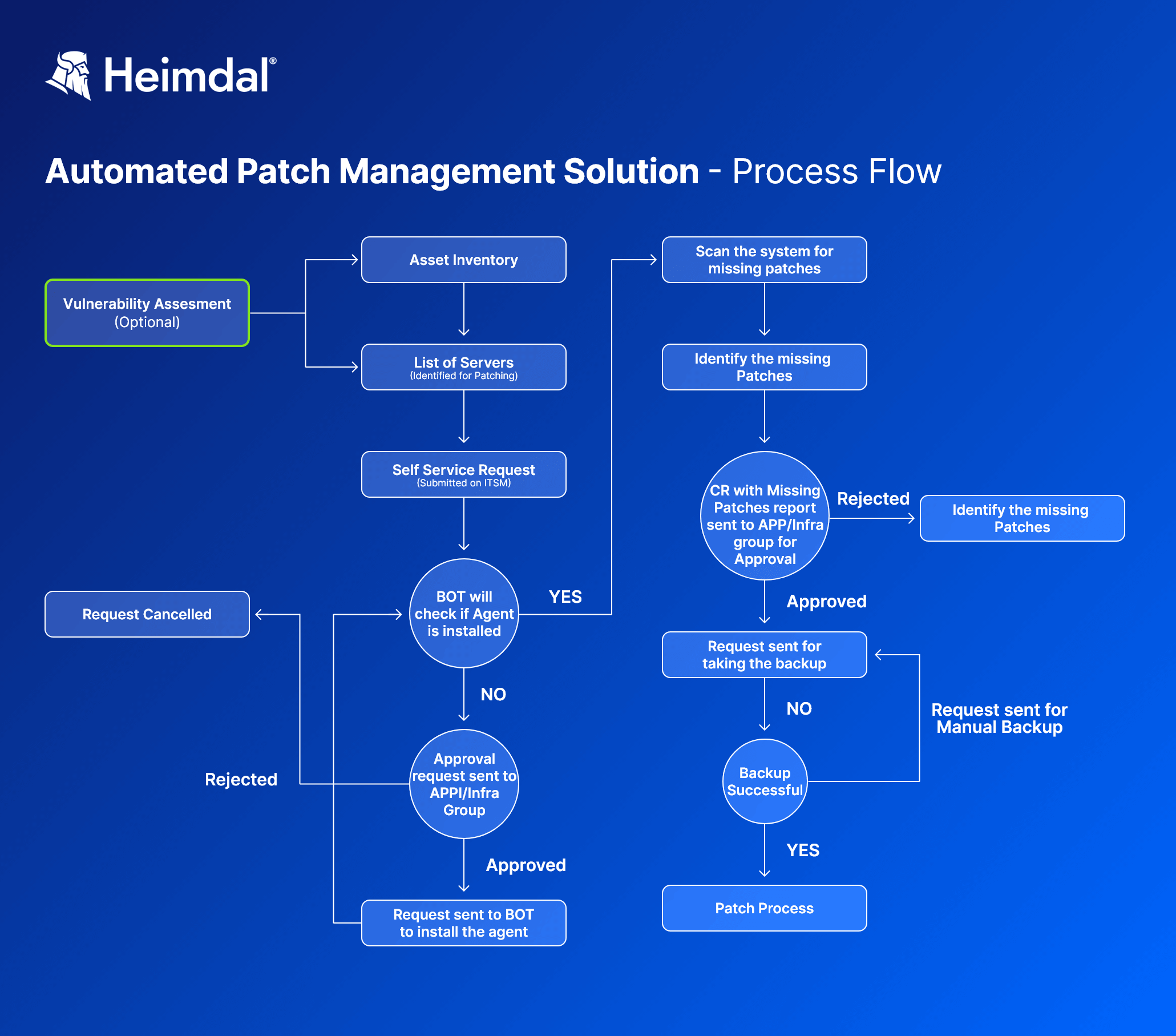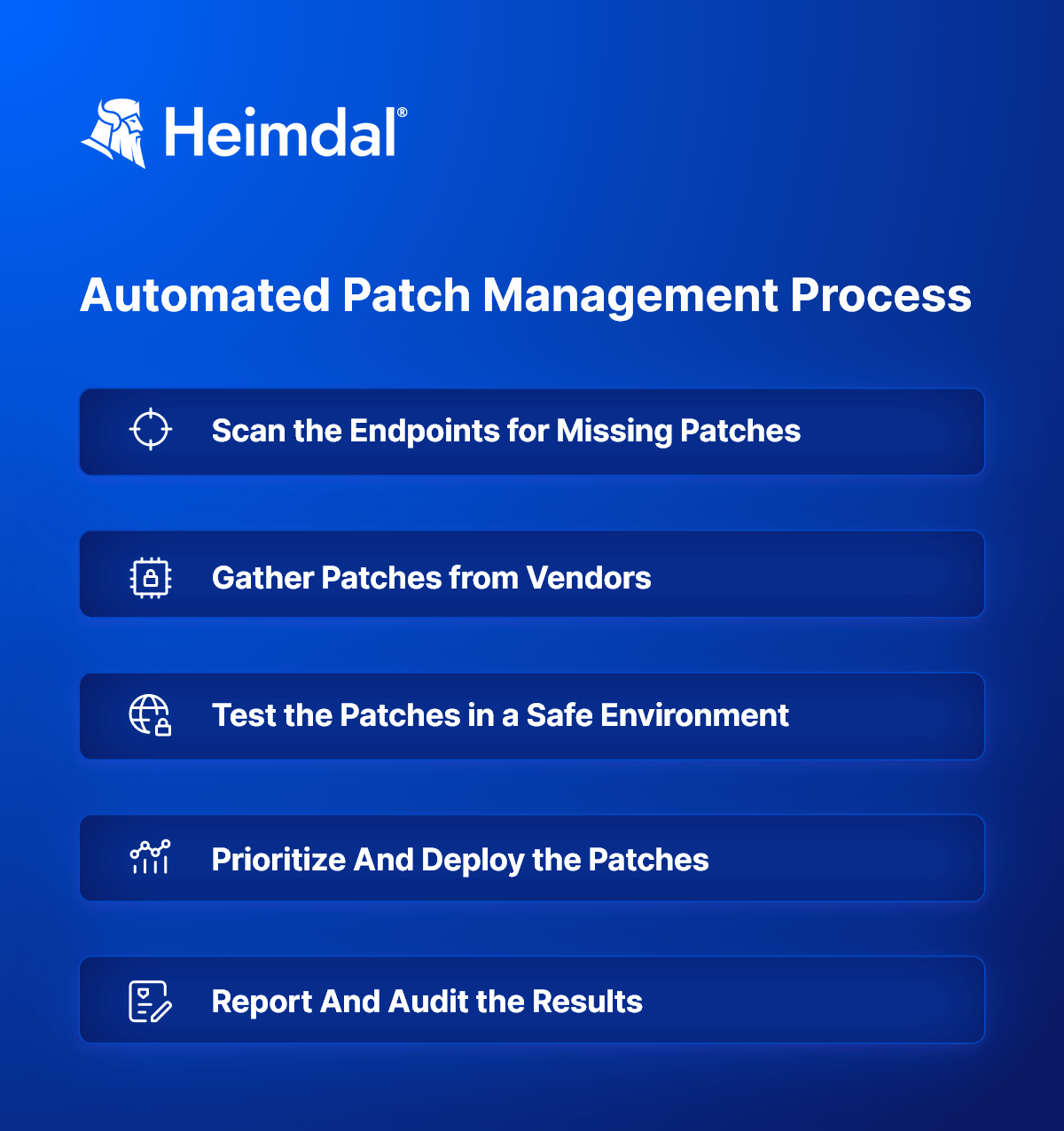Contents:
Vulnerability-based breaches grew by 34% since last year, and that makes implementing automated patch management more important than ever.
Researchers found that it takes an average of 32 days to fix them—if they’re fixed at all. In fact, only 54% of perimeter device flaws get fully patched, giving attackers a wide window to strike. The numbers come from the recently released Data Breach Investigation Report (DBIR) 2025, and they should raise a question mark for companies that still apply patches manually.
Staying on top of newly released patches isn’t just good practice—it’s essential for modern cybersecurity.
With an automated patch management software, your systems and important apps will be constantly up to date and vulnerability-free. Let’s get going and take a look at how automated patch management can help your company!
Key Takeaways
- Automated patch management eliminates manual processes, significantly reducing the time and effort required to update systems.
- Automation ensures that patches are applied with minimal disruption to business operations, keeping systems running smoothly.
- By automatically applying patches, vulnerabilities are addressed quickly, reducing the risk of cyberattacks and data breaches.
- Automated solutions help organizations stay compliant with industry regulations by ensuring timely patching and providing detailed reporting.
- Automated patch management can easily scale across large networks, managing patches for various software and systems without requiring manual intervention.
What Is Automated Patch Management?
Automated patch management refers to the automation of the entire patch management process, from scanning to testing, deploying, and reporting.
An automated patch management software will significantly reduce the pressure on your IT team, increase overall productivity, reduce downtime, and decrease the level of human error. Heimdal’s patch management solution, for example, offers the industry’s shortest vendor-to-end-user waiting time. It applies patches in less than 4 hours, testing included.
An automated patching solution will also make sure that threat actors have few to no ways to infiltrate your systems.

How Does an Automated Patch Management Solution Work?
- It is used to automate the various stages of the patching process;
- Scans the applications of devices for missing patches;
- Automates the downloading of missing patches that are released by the application vendors;
- Automatically deploys patches based on the deployment policies, without any manual interference;
- Reports on the status of the automated patch management tasks that are updated.
Automated vs. Manual Patching
It is nearly impossible to conclude that one trumps the other when evaluating automatic vs manual patching. This is because it is entirely dependent on the context; automatic updating is preferable in some cases, while manual updating is preferable in others.
Here’s how to tell when to utilize which:
When to Use Automated Patch Management?
Automatic patch management updates are ideal for the following situations:
- Fixes for system flaws that are absolutely necessary;
- Updates to the operating system that have been carefully tested and validated by suppliers;
- Updates that can be readily undone if something goes wrong.
When to Use Manual Patch Management?
Manual patch management updates are ideal for the following situations:
- Updates for firmware and network switches that are not reliable.
- Updates for systems and servers that are crucial to corporate operations (a critical server crashing in the middle of the day is a significant problem).
The idea is to take advantage of risk-free automatic updates while simultaneously employing manual procedures as necessary.
Patch management technologies are typically deployed initially to standardized desktop systems and single-platform server farms of servers with comparable configurations. After that, organizations should aim to integrate multi-platform environments, nonstandard desktop systems, older PCs, and computers with unusual setups, which is a more complex task.
For operating systems and applications that aren’t supported by automated patching tools, as well as some PCs with odd settings, manual procedures may be required.
However, to make the most out of patching, using an automated patch management software is not only the more reliable option that brings benefits across the board, but it’s also the safest. The recommendation is to rely on manual patching only in exceptional cases.
Automated Patch Management Process
To better understand automated patch management, let’s take a look at the process.

- Scanning the Endpoints for Missing Patches: the first point on the list is to scan the endpoints in your network for missing patches. The scans can either be automated via scheduling or generated on demand;
- Gathering Patches from Vendors: it is necessary to download the missing patches from the vendor sites (such as Adobe, Java, Google, Cisco, and others) after they have been located. Patches can be downloaded manually from vendor websites or automatically using an automated patch management tool. Without any manual dependencies, this automation makes sure that the missing patches are downloaded as soon as they are found on the network;
- Testing the Patches in a Safe Environment: sometimes, patches may cause anomalies and affect how apps perform. This is why it is important to test patches in a safe virtual environment similar to your real one. Testing can save you from potential downtime or drops in the efficiency of employees;
- Prioritization And Deployment of Patches: once the patches are successfully tested and approved, you can move on to the next step and schedule them for deployment to the systems. However, it is important to prioritize the deployment of patches based on their severity (critical, high, moderate, etc.). With an automated solution in place, this process can be done more easily, faster, and without errors;
- Reporting And Auditing: due to compliance requirements, reporting and auditing the entire patch management process is an important step in the process. Luckily, it is almost instant due to automated patching.
Benefits of Automated Patch Management: Why Is It Important?
If you’ve never faced a security incident, you might not fully understand the true importance of the patch management process. However, ignoring the risks is never an option, as both small businesses and enterprises can be harmful due to non-existent or delayed patching.
Without any further ado, here is why you should use automated patch management:
1. It’s Secure
I think we can all agree that security is the most important advantage of patch management. Security breaches are generally caused by missing patches in operating systems and other applications. Comprehensive patch management can guard against vulnerabilities across different platforms and OS. By protecting your systems before cybercriminals leverage any flaws, you prevent breaches and avoid compliance issues and reputational damage that frequently accompany organizations affected by cyberattacks.
2. It Increases Productivity Across Departments
Despite having top-notch technology, computer crashes still happen. And so do malware attacks. This can eventually lead to lower productivity levels. However, a patch reduces the possibility of crashes and downtime, thus allowing employees to carry on with their tasks without interruptions.
Plus, an automated patch management solution will also give your IT department more time to handle more urgent problems. Manually patching the endpoints of an organization is a daunting task that, depending on the number of endpoints, it’s both time consuming and resource consuming.
3. It Complies With The Latest Security Regulations
Cyberthreats have become widespread, therefore regulatory bodies are demanding that businesses apply the latest patches to avoid these attacks. Noncompliance may result in your organization facing legal penalties, so a good patch management strategy is necessary to comply with these standards. An automated patch management solution like our Heimdal® Patch & Asset Management ensures you stay within compliance and that you are provided with a complete CVE/CVSS audit trail.
4. It Provides an Overview of Your Business Environment
I highly recommend that you stop using software that no longer offers technical support. Frequently, vendors stop providing patches for their software for various reasons – they are working on the next version, the company collapsed and is not producing bug fixes anymore, etc. Patch management helps you identify such software, so you know when to replace it with a new one.
5. It Reduces Human Error
There is little doubt that deploying updates to hundreds of systems is redundant. Another difficult chore is making sure patches are installed for the various operating systems and applications. While a human error can be fata to the organization’s network security, it can be easily prevented by leveraging automated patching methods. Furthermore, it also ensures better utilization of resources across the organization.
Automated Patch Management Best Practices
Patch management solutions can be affiliated with automation software to enhance configuration and patch precision while downsizing errors. The added capabilities automation provides translate to identifying, testing, and patching systems with decreased manual input.
As I’ve previously stated, the main purpose of automated patch management is to approach the patching process in a proactive manner. Below you will find four prominent aspects that will help you boost your patching efficiency and effectiveness.
1. Identify systems that are non-compliant, vulnerable, or unpatched.
Today’s IT systems present a challenge because most systems run dozens of different software titles. You can’t know what you need to patch until you know what you have – OS, server applications, and desktop applications.
2. Prioritize patches based on the potential impact.
Based on the patch rating and configuration of your systems, you need to decide which systems need the patch and how quickly they need to be patched to prevent an exploit. And as a bonus, you can set some patch & vulnerability management-related KPIs.
3. Patch frequently.
Patches are usually shipped once a month or sooner. Set a regularly scheduled routine every month to patch your systems. You can do it most efficiently all in one big event over a weekend, where all systems are patched.
4. Test patches before deploying them across your organization.
Before deploying a patch, you need to test it on a testbed that simulates your production network. All networks and configurations are different, so you need to test for every combination and make sure your network(s) can properly run the patch. An automated patch management solution will have you greatly in this situation.
How Can Heimdal® Help You Automate the Patching Process
When it comes to automated patching, Heimdal® has the best solution for you.

With Heimdal®’s Patch & Asset Management software, you can achieve complete patching automation fast and easy.
With our solution, you will be able to:
- Patch operating systems such as Windows, Linux, and macOS, Third-Party, and even proprietary apps, all in one place;
- Generate software and assets inventories;
- Easily achieve compliance with automatically generated detailed reports (GDPR, UK PSN, HIPAA, PCI-DSS, NIST);
- Automatically conduct vulnerability and risk management processes;
- Close vulnerabilities, mitigate exploits, deploy updates both globally and locally, anytime, from anywhere in the world;
- Customize your solution based to perfectly fit the needs of your organization.
Not only that, but we also provide you with fully tested, repackaged, and ad-free updates using encrypted packages inside HTTPS transfers locally to your endpoints. The newly released patches are ready for deployment to customers in less than 4 hours.
By efficiently managing vulnerabilities, you will demonstrate a high ROI and improve your cybersecurity posture within a short timeframe.
Wrapping It Up…
To conclude it all, so far we have pretty much dissected the subject of automated patch management, and in today’s fast-paced cybersecurity landscape, having an automated solution to automatically take care of possible points of entry for attackers is definitely an advantage.
And furthermore, it also help with increasing productivity levels, by reducing down-time and freeing up resources, both computer and server resources, but also human resources. Manual patching definitely has its advantages, especially for companies with a small number of machines, but for companies with a large number of endpoints, having an automated patch management solution implemented is almost essential.
If you want to find out more about automated patch management, we have some resources prepared for you to access below. Also, you can read more about patch management in general by accessing the dedicated category on our blog, or the Patch Tuesday category, to stay up-to-date with the latest Microsoft monthly fixes.
Additional Resources on Automated Patch Management
Frequently Asked Questions
What is patch management in automation?
Patch management in automation refers to the use of software tools to automatically identify, download, and install security updates (patches) across an organization’s systems. This process ensures that software vulnerabilities are addressed promptly without requiring manual intervention. Automated patch management helps reduce the risk of cyberattacks by ensuring patches are applied consistently and efficiently, minimizing the chance for human error.
What is the difference between manual and automated patching?
Manual patching requires IT teams to manually check for available updates, download the patches, and apply them to systems. This process can be time-consuming and prone to errors. In contrast, automated patching uses specialized software to handle the entire patching process without human intervention. Automated solutions ensure patches are applied more quickly, reducing security risks and saving time, while manual patching can lead to delays and missed updates, increasing vulnerability.
What is remote patch management?
Remote patch management is the process of deploying and managing patches on systems that are not physically on-site, such as those in remote locations or used by remote employees. Using automated tools, IT teams can schedule, deploy, and monitor patches from a central location, ensuring that all systems, regardless of where they are, stay up-to-date with the latest security fixes. Remote patch management is crucial for organizations with a distributed workforce or global operations.
How to automate vulnerability patching?
To automate vulnerability patching, organizations need to implement a patch management solution that scans systems for vulnerabilities, automatically downloads available patches, and schedules installations. The process can be configured to run regularly, ensuring vulnerabilities are addressed quickly. Best practices include enabling notifications, testing patches in a controlled environment, and using centralized dashboards to monitor the success of automated patching efforts.










 Network Security
Network Security
 Vulnerability Management
Vulnerability Management
 Privileged Access Management
Privileged Access Management  Endpoint Security
Endpoint Security
 Threat Hunting
Threat Hunting
 Unified Endpoint Management
Unified Endpoint Management
 Email & Collaboration Security
Email & Collaboration Security













